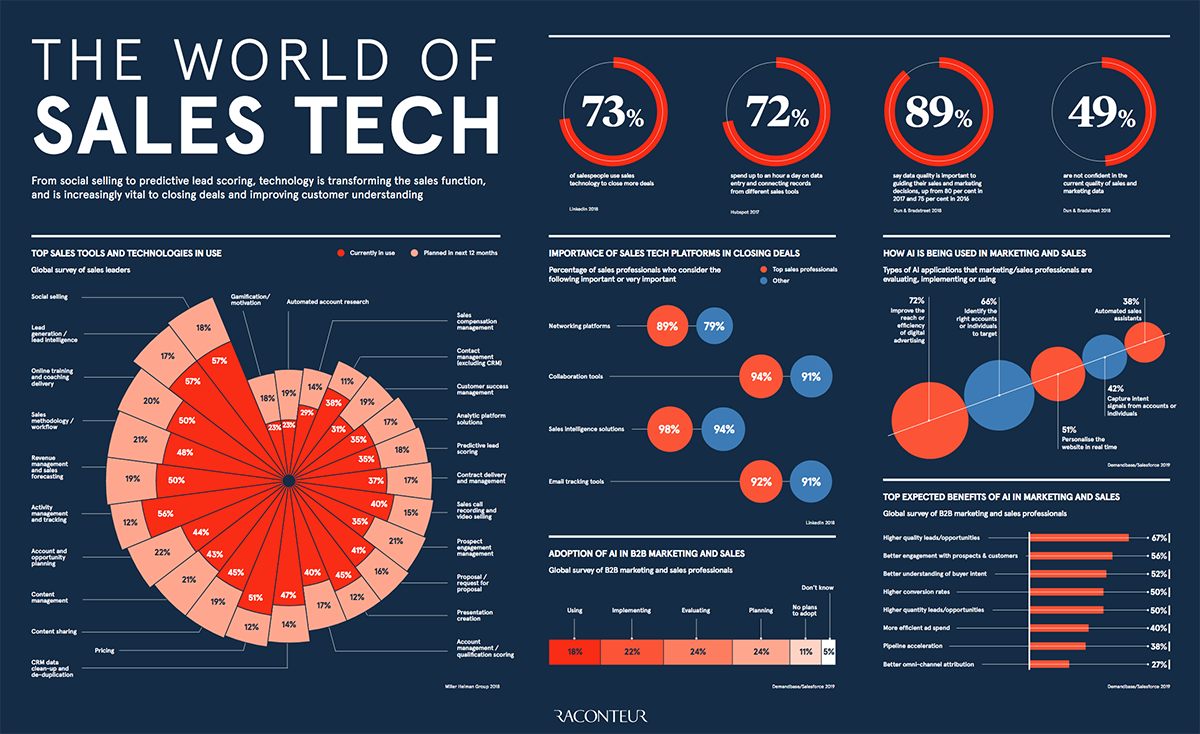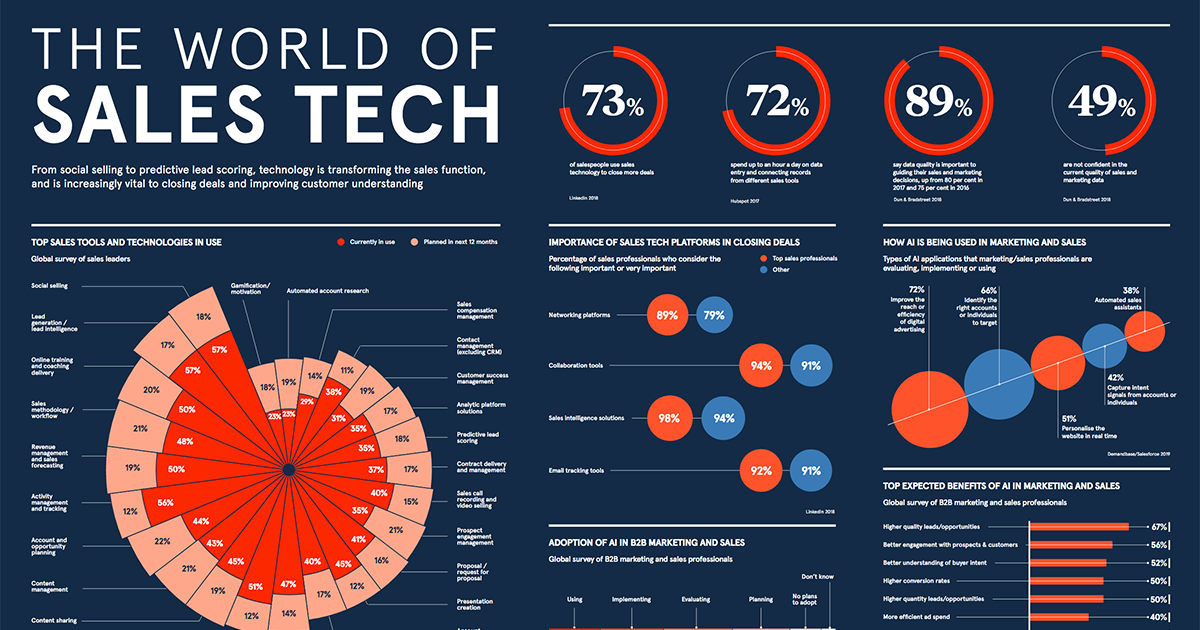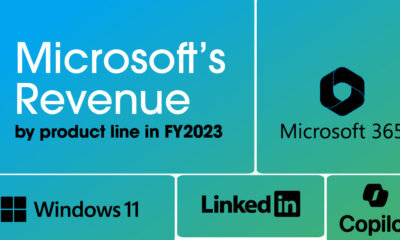Technology
Visualizing the World of Sales Technology
View the full-resolution version of this infographic
Visualizing the World of Sales Technology
“Always Be Closing.”
This infamous phrase was popularized in the 1992 film Glengarry Glen Ross, and has become a mantra among fervent salespeople.
While sealing the deal is always the ultimate goal, salespeople actually spend the majority of their time on other tasks like generating and nurturing prospects, following up with customers, and finding new sales opportunities. For this reason, nearly three-quarters of sales professionals rely on technology to do those less glamorous tasks faster and more efficiently.
Today’s graphic from Raconteur shows the value of technology in today’s sales world and how artificial intelligence (AI) technology ultimately helps sales reps win more business.
Artificial Intelligence in Sales
Globally, 40% of salespeople use or are implementing AI technology into their workflows to automate or streamline sales.
AI-based sales technology helps to:
- Identify the best leads to target using past customer data
- Improve the quantity and quality of leads
- Increase omnichannel customer engagement
- Personalize customer information in real-time
- Automate sales tasks such as contact information data entry
Using AI tools could mean the difference between closing a deal or losing a prospect.
Companies that automated their contact form responses, for example, saw a 71% increase in open rates and a 152% increase in clickthrough rates.
Growth of Sales Technologies and Tools
With at least two dozen major sales tech segments projected to grow in the next few years, five technologies stand to gain the most traction.
1. Account and Opportunity Planning
Refined data from past and existing customers offer valuable insights on which future prospects to target. Using these insights and other key data (company lists), sales intelligence tools can create custom search criteria to narrow down the best leads to approach.
These tools merge seamlessly with analytics, marketing, and data management to prevent information silos within a company.
2. Sales Methodology/Workflow
Customer relationship management (CRM) is now the fastest-growing software sector in the world. The CRM market is expected to double from $40 billion in 2019 to $80 billion by 2025.
Salespeople can use tools like Salesforce to manage leads and customers effectively and even assist other internal teams with more personalized customer interactions, such as customer service.
3. Content Management
In this information-rich age, companies are expected to keep customer information secure. Content Management Software (CMS) such as Confluence or Paperflite allows sales teams to instantly organize, collaborate on, and distribute internal documents and resources with one another to maintain up-to-date files.
4. Prospect Engagement Management
Customers want products and services tailored to their specific needs and desires. Many companies using a series of personalized emails to welcome or re-engage online customers found they could close 75% more in sales.
5. Online Training and Coaching Delivery
With new technologies, more nuanced client data, and shifting public perceptions of brands, top salespeople are seeking out efficient methods to maintain their skills. This helps them to better connect with prospects and manage sales pipelines.
Technology in the Sales Workflow
Top sales professionals have weighed in—sales technology platforms and tools are invaluable to their success. An overwhelming majority of salespeople use these tools every day:
- 98% use sales intelligence solutions that provide insight and automation.
Examples: InsideView, Nimble, Clearbit - 94% use collaboration tools to keep their finger on the pulse of sales activities.
Examples: Wrike, Basecamp, Slack - 92% use email tracking tools to track campaigns and conversions.
Examples: Ebsta, Clearslide, Hubspot Sales
Using more refined software tools, salespeople are able to make better-informed decisions about which prospects to nurture and which ones to grow organically.
And as Glengarry Glen Ross reminds us: “Coffee’s for closers only.”
Technology
All of the Grants Given by the U.S. CHIPS Act
Intel, TSMC, and more have received billions in subsidies from the U.S. CHIPS Act in 2024.

All of the Grants Given by the U.S. CHIPS Act
This was originally posted on our Voronoi app. Download the app for free on iOS or Android and discover incredible data-driven charts from a variety of trusted sources.
This visualization shows which companies are receiving grants from the U.S. CHIPS Act, as of April 25, 2024. The CHIPS Act is a federal statute signed into law by President Joe Biden that authorizes $280 billion in new funding to boost domestic research and manufacturing of semiconductors.
The grant amounts visualized in this graphic are intended to accelerate the production of semiconductor fabrication plants (fabs) across the United States.
Data and Company Highlights
The figures we used to create this graphic were collected from a variety of public news sources. The Semiconductor Industry Association (SIA) also maintains a tracker for CHIPS Act recipients, though at the time of writing it does not have the latest details for Micron.
| Company | Federal Grant Amount | Anticipated Investment From Company |
|---|---|---|
| 🇺🇸 Intel | $8,500,000,000 | $100,000,000,000 |
| 🇹🇼 TSMC | $6,600,000,000 | $65,000,000,000 |
| 🇰🇷 Samsung | $6,400,000,000 | $45,000,000,000 |
| 🇺🇸 Micron | $6,100,000,000 | $50,000,000,000 |
| 🇺🇸 GlobalFoundries | $1,500,000,000 | $12,000,000,000 |
| 🇺🇸 Microchip | $162,000,000 | N/A |
| 🇬🇧 BAE Systems | $35,000,000 | N/A |
BAE Systems was not included in the graphic due to size limitations
Intel’s Massive Plans
Intel is receiving the largest share of the pie, with $8.5 billion in grants (plus an additional $11 billion in government loans). This grant accounts for 22% of the CHIPS Act’s total subsidies for chip production.
From Intel’s side, the company is expected to invest $100 billion to construct new fabs in Arizona and Ohio, while modernizing and/or expanding existing fabs in Oregon and New Mexico. Intel could also claim another $25 billion in credits through the U.S. Treasury Department’s Investment Tax Credit.
TSMC Expands its U.S. Presence
TSMC, the world’s largest semiconductor foundry company, is receiving a hefty $6.6 billion to construct a new chip plant with three fabs in Arizona. The Taiwanese chipmaker is expected to invest $65 billion into the project.
The plant’s first fab will be up and running in the first half of 2025, leveraging 4 nm (nanometer) technology. According to TrendForce, the other fabs will produce chips on more advanced 3 nm and 2 nm processes.
The Latest Grant Goes to Micron
Micron, the only U.S.-based manufacturer of memory chips, is set to receive $6.1 billion in grants to support its plans of investing $50 billion through 2030. This investment will be used to construct new fabs in Idaho and New York.
-

 Science1 week ago
Science1 week agoVisualizing the Average Lifespans of Mammals
-

 Demographics2 weeks ago
Demographics2 weeks agoThe Smallest Gender Wage Gaps in OECD Countries
-

 United States2 weeks ago
United States2 weeks agoWhere U.S. Inflation Hit the Hardest in March 2024
-

 Green2 weeks ago
Green2 weeks agoTop Countries By Forest Growth Since 2001
-

 United States2 weeks ago
United States2 weeks agoRanked: The Largest U.S. Corporations by Number of Employees
-

 Maps2 weeks ago
Maps2 weeks agoThe Largest Earthquakes in the New York Area (1970-2024)
-

 Green2 weeks ago
Green2 weeks agoRanked: The Countries With the Most Air Pollution in 2023
-

 Green2 weeks ago
Green2 weeks agoRanking the Top 15 Countries by Carbon Tax Revenue
















